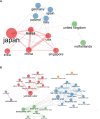Hepatic arterial infusion chemotherapy in hepatocellular carcinoma: A bibliometric and knowledge-map analysis
- PMID: 36686799
- PMCID: PMC9846108
- DOI: 10.3389/fonc.2022.1071860
Hepatic arterial infusion chemotherapy in hepatocellular carcinoma: A bibliometric and knowledge-map analysis
Abstract
Background: In recent years, hepatic arterial infusion chemotherapy (HAIC) has gained popularity in the treatment of hepatocellular carcinoma. Although several studies have been published, no bibliometric analysis have been conducted on this topic.
Objectives: To understand the development status and future trends in the application of HAIC, we conducted bibliometric analysis to examine the cooperation and influence among countries, institutions, authors, and journals.
Methods: All relevant articles and reviews on the use of HAIC in HCC treatment were retrieved from the Web of Science database. A bibliometric analysis of countries, institutions, journals, authors, and keywords related to this field was performed using R and VOSviewer software. The main aspects analyzed were the research status and key fields of HAIC in HCC treatment.
Results: A total of 1026 articles published in 292 journals by 4937 authors from 959 institutions between 1974 and 2021 were retrieved. A rapid increase in articles published after 1990 was observed, which reached the peak in 2021. Japan had the most publications and citations. Yonsei University, Sun Yat-sen University, and Hiroshima University were the three leading institutions in research on this topic. Kwang-Hyub Han and Masatoshi Kudo have the greatest academic influence in this field. Most publications were made in the Hepato-Gastroenterology, whereas cancer had the most citations. The main aspects of HAIC treatment of HCC include HAIC and TACE, chemotherapy drug selection, HAIC and targeted therapy and immunotherapy, HAIC and surgery, and hepatotoxicity. Keywords such as FOLFOX, lenvatinib, hepatic arterial infusion chemotherapy are hot words in this field in recent years.
Conclusion: The research on the use of HAIC in the treatment of HCC has been on the rise. Currently, HAIC combined with targeted therapy or immunotherapy has attracted significant attention.
Keywords: FOLFOX; bibliometric; data mining; hepatic arterial infusion chemotherapy; hepatocellular carcinoma.
Copyright © 2023 Li, Zhang, He, Zhang, Lv, Wang, Xing and Yu.
Conflict of interest statement
The authors declare that the research was conducted in the absence of any commercial or financial relationships that could be construed as a potential conflict of interest.
Figures




References
LinkOut - more resources
Full Text Sources
Miscellaneous

